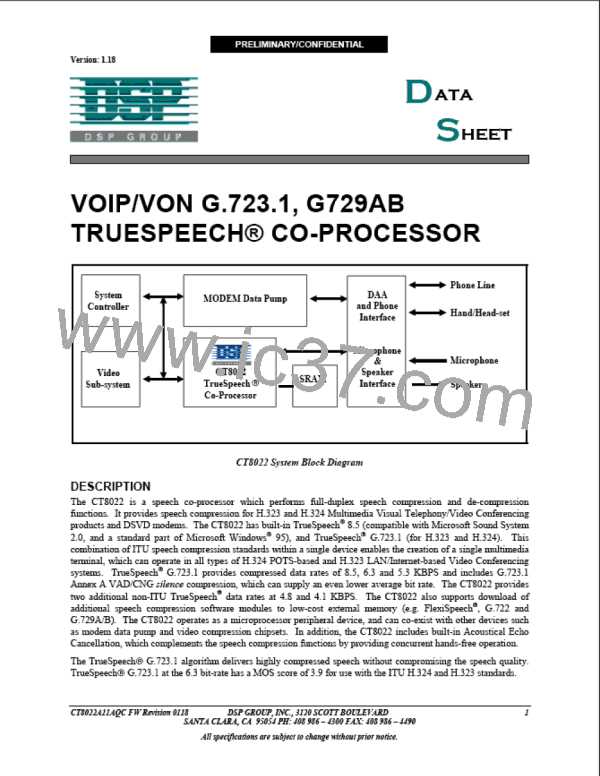Version: 1.18
PRELIMINARY/CONFIDENTIAL
TrueSpeech® Co-Processor
9.14
Full-Duplex Speech Mode
Full-duplex (DSVD) speech mode is the simple combination of playback and record operating concurrently (and
independently). Starting both Playback and Record (which starts first doesn’t matter) will enter full-duplex mode.
If the Host wishes to take advantage of the fact that the CT8022 record and playback data streams are synchronous,
so as to use a single interrupt source to generate an interrupt for both record and playback, the RX READY interrupt
should be used. Internally, the CT8022 process the playback data stream before processing the record data stream.
Therefore, under normal circumstances, the RX READY (record) indication will be asserted after TX READY
(playback). Because of the playback-then-record order, at the time the RX READY condition is asserted, the TX
READY will normally also be set. At this time, the Host can perform data transfers for both TX and RX directions.
The only disadvantage to this approach is the restriction imposed on the Host response time when the CT8022’s
internal playback buffer is empty and the internal DSP is operating at close to 100% load. In a minimum delay
environment, the Host may wish to attempt to keep the CT8022’s internal buffers empty for as long as possible.
Reducing the amount of speech buffered within the CT8022 will keep the end-to-end delay to a minimum. Under
these circumstances, the response time of the Host using the RX READY assertion until completion of playback data
transfer to the CT8022 must be shorter, otherwise playback data under-run will occur.
The diagram below shows typical CT8022 internal processing activity during one 30ms frame period.
30 ms Frame Period
Playback
Processing
Record
Processing
Playback
Processing
AEC processing
Idle
AEC processing
Start
Playback TX
RX
Start
Playback
data must
be ready
of
data must READY
READY of next
asserted Frame
Frame
be ready
asserted
Host Response Time when
using seperate TX and RX
interrupts
Host Response Time when
using a single interrupt
Figure 9-2:
CT8022 Internal Processing Activity
The Host Response Time is only an issue if the Host is attempting to implement a minimum delay system, where the
CT8022’s internal buffers are not used to provided additional latency (buffering or de-jitter). If minimum delay is
not required, the CT8022’s playback buffer can be used to provide extra buffering such that there is always at least 1
speech frame ready and waiting in the playback buffer. In this situation, the Host always has at least a 1-frame
period latency in which to respond to the TX READY condition.
CT8022A11AQC FW Revision 0118 DSP GROUP, INC., 3120 SCOTT BOULEVARD
SANTA CLARA, CA 95054 PH: 408 986 – 4300 FAX: 408 986 – 4490
99
All specifications are subject to change without prior notice.

 ETC [ ETC ]
ETC [ ETC ]